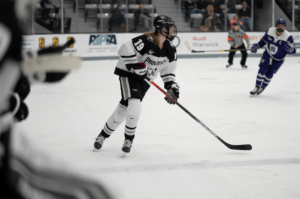by Andrea Traietti on March 5, 2020
Opinion

by Savannah Plaisted ’21
Opinion Co-Editor
Have you ever noticed the difference between going to a women’s hockey game and a men’s hockey game at Providence College? It is not the location of the game, or the skill level of the athletes. It is simply $4.
In order to gain entry to men’s hockey games on this campus, one must pay $4, while being charged nothing for women’s games. Some may say this is because of the level of attendance to the games, but is that not insulting to the women that practice just as hard as the men?
In a recent poll run by The Cowl, 63 percent of students agreed that it should cost the same to attend men’s and women’s sporting events, whether they be free or otherwise. If PC can afford to charge nothing at female games, it is clear that charging such a small rate for the men’s games is only the case in order to increase pre-existing profit margins. The College should either split the cost and charge $2 for entry to games of either gender, or make both free, in the name of gender equality.
This issue and others like it have been making national attention recently, especially in light of the recent 2019 World Cup win by the U.S. Women’s National Team. This win provided female athletes with a platform for voicing their concerns over the vast discrepancies in payment of male and female athletes. Female athletes for the USWNT were paid far less than their male counterparts, even while they won the World Cup and the men’s team failed to do so. Is that discrepancy not completely unjust?
According to the Washington Post, “Total prize money for the Women’s World Cup in 2019 is $30 million.” Meanwhile, “in the 2018 Men’s World Cup, the champions won $38 million from a total pool of about $400 million.” On top of this, outside of a World Cup atmosphere, in a 20 game scenario established for the purposes of the lawsuit by the USWNT, female athletes received about, “89 percent of the compensation of a similarly situated men’s team player.”
This is a clear indication of the sexism that is inherent in the world of athletics, given that these same women’s teams brought in equal if not more revenue in the year that this case was analyzed. One of the biggest arguments brought about in regards to the equal pay of athletes across gender lines is the idea that because the female organizations fail to achieve the same levels of revenue, they should by default be paid less. This clearly is not the case for the USWNT.
Meanwhile, here at PC, the women’s basketball team plays in Alumni Hall and does not receive anywhere close to the same amount of advertising as men’s basketball. One may argue that this is due to the fact that the female team does not bring in the same revenue, yet how should they be expected to when they receive varying degrees of advertising and play on-campus instead of in an outside arena that is arguably more open to the public?
Students are constantly peppered with emails regarding men’s basketball games—not only advertising the games in advance but also reporting the scores of the games immediately afterwards. Where are the women in this advertising? Both teams must be placed upon a level playing field in terms of the resources they are accorded in order to produce revenue, before it can be determined which team truly provides the most.
Women’s hockey at PC voiced the same concern, as Maureen Murphy ’21 said, “We wish they would advertise us more even though we aren’t a revenue-generating sport.” The fact of the matter is, each and every female sport at PC is capable of drawing in far more revenue, if they were only granted the same opportunities as the men’s sports on this campus.
With that being said, the College and the athletic department need to consider the social implications of putting male sports at an advantage on this campus, especially given the fact that this is an issue playing out on a global scale in today’s mass media.